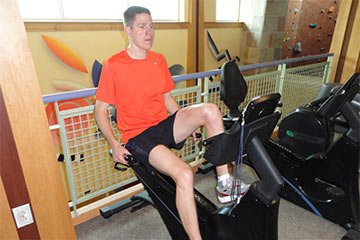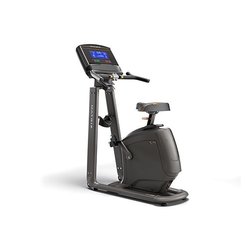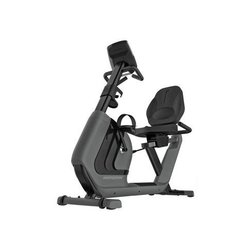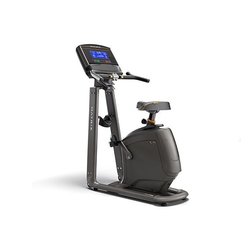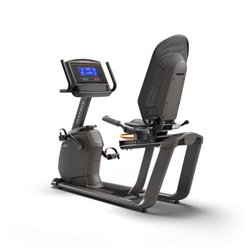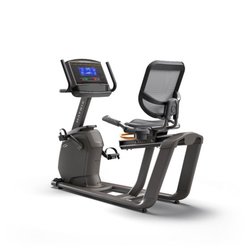Buyer's Guide to Exercise Bikes
Exercise bikes (also called stationary bikes) provide an excellent, impact-free, seated workout that engages the large muscles of the lower body and your heart and lungs for a solid aerobic workout and efficient fat burning. They're a great choice for your home whether you're a cyclist planning to supplement your outdoor riding, a runner that wants an impact-free, cross-training option, or you're just looking for a fun and effective exercise to increase your activity level.
Exercise bikes are easy to use, require little or no learning curve and are gentle on your joints. All these things make them a safe choice for your home. And, with so many styles available, there's certainly a bike for you.
The vast majority feature a compact frame and transport wheels (so they're easy to move). You'll also find a number of machines that are self-power generated, meaning that they require no external power source. Plus, most high-quality stationary bikes make little noise. Any or all of these features make it quite easy to incorporate an exercise bike into almost any room in your home.
If you own a regular bicycle, you also have the option of purchasing an indoor trainer or rollers instead of an exercise bike. Then, you can place your bike on the trainer or rollers and ride indoors. For the purposes of this article, however, we focus exclusively on your exercise-bike options.
Plenty of Choices
Now's the ideal time to shop for an exercise bike. Today, manufacturers offer many types, and within each category you’ll find varying prices points and features, all designed to offer a good bike with the features you want and need to burn calories and fat and stay healthy and fit.
So that you're not overwhelmed with all the choices, this comprehensive guide walks you through all aspects of exercise bikes and helps you determine which features are important, and which you can live without. You may be looking for a highly adjustable indoor cycling bike to replicate your outdoor riding position, while someone else is looking for a recumbent bike with a step-through frame, a wide, cushioned seat and extensive console programming options.
Once you determine what qualities and features are important to you, you just have to try those bikes that meet your criteria, and choose the model that feels the best. Use the quick links below to jump to different parts of this guide if you like.
To start, here's a quick look at the four primary styles of exercise bikes available today:
| Type | Description | Features | Ideal Use |
Upright Exercise Bike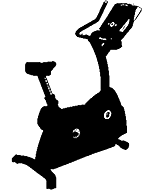 | A classic upright stationary bike. | Upright riding position with pedals below you and seat-height adjustment. Sometimes the handlebars allow a more aggressive riding position. Usually includes a console, often with built-in workout programs. | Maintain outdoor-specific cycling fitness. |
| Recumbent Exercise Bike 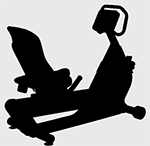 | A reclining stationary bike for added support and comfort. | Reclined riding position with a wide seat, back support and pedals in front of you. Usually includes console, often with built-in workout programs. | Good option for someone who isn't comfortable on a traditional bike seat, needs back support, has balance difficulties or prefers hands-free riding. |
Indoor Cycling Bike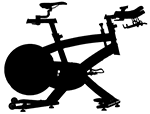 | An upright exercise bike that fits and rides more like your outdoor bike. | More seat and bar adjustability for a perfect fit. Micro-adjustable resistance for personal fine-tuning. Weighted flywheel and direct drive allow out-of-the-seat riding. Seat and pedals can usually be replaced with your favorites. May have optional console. | Train indoors as you would outdoors in your regular cycling position |
| Dual-Action Exercise Bike 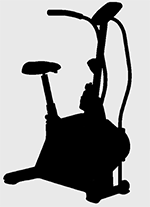 | An upright or recumbent bike with moving arms. | Bars move in concert with the pedals for a full-body workout. May include console with workout feedback. | Burn more calories and exercise efficiently with your upper body sharing in the exercise. |
A Few Questions
Before you visit our store, ask yourself a few questions so that you’re better prepared to make this important decision and find your new exercise bike:
- Who will use your exercise bike?
- What type(s) of stationary bikes have you ridden in the past?
- What type of workouts will you perform on your exercise bike?
- How often will your stationary bike be used (daily, seasonally, year-round)?
- What are your (and other users’) goals?
- Where will you put your exercise bike?
You should also keep in mind your exercise history, the reason you’re buying the exercise bike and the goals you hope to accomplish. If you’ve previously used stationary bikes or other cardio machines, consider what features you enjoyed before, such as mesh seat backs on recumbent bikes, fore/aft handlebar positioning on indoor cycling bikes, workout programs and heart-rate monitoring.
And, understand that the commercial exercise bike you may have used in a health club or recreation center is likely priced at $1,000 or more for an indoor cycling bike and from $3,000 to $6,000 for a recumbent or traditional upright bike. While it’s unrealistic to expect the identical home exercise bike experience for only a fraction of the cost, you can find a great number of high-quality, home stationary bikes that will deliver a similar experience.
If you’re new to exercise bikes, beware falling into the common trap of buying a cheap bike just to see if you’ll use it. The problem here is that you’ll be setting yourself up for failure with an uncomfortable, unstable and noisy exercise bike that will disappoint you with every pedal revolution. Whereas if you get a quality bike it will be fun to ride and you'll be much more likely to stick with your exercise program and achieve your goals.
When deciding on your new exercise bike, take into account who will be using it now and in the future. Initially, you may be the primary or only user. But, a high-quality stationary bike will serve you well for many years to come. You might have young children now that will find athletic or fitness benefits from the exercise bike as they grow older. And, your healthy behavior may inspire others to begin riding the bike.
A Comfortable Fit and Feel
It's crucial to find an exercise bike that's comfortable, fits you well, and feels good while pedaling. A stationary bike may be well built and super reliable, but if it doesn't fit you, you don't like how the seat feels, or the pedaling doesn't feel smooth, you're not going to ride it much. Click the illustration below to view some of the adjustment options available depending on the exercise bike type.
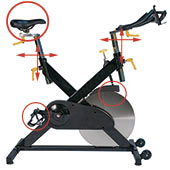 Pedaling smoothness is determined by the drivetrain and resistance mechanism. Exercise bikes use chain or belt drivetrains. While both are smooth, durable and reliable, belt drives are almost always smoother and quieter. The quietest and smoothest resistance mechanisms are eddy-current brakes and alternators, which are explained more later so keep reading.
Pedaling smoothness is determined by the drivetrain and resistance mechanism. Exercise bikes use chain or belt drivetrains. While both are smooth, durable and reliable, belt drives are almost always smoother and quieter. The quietest and smoothest resistance mechanisms are eddy-current brakes and alternators, which are explained more later so keep reading.
The fit and comfort of your exercise bike largely depends on the seat and handlebars, and how adjustable they are. This varies with the different types of exercise bikes, so we've put together this chart to explain how the different types are equipped:
| Type | Seat | Handlebars |
| Upright Exercise Bike | Commonly equipped with a wide, cushioned seat, while some sport a firm, narrow seat similar to what's found on a road or mountain bike. Some seats can be replaced with your favorite, but sometimes the seat is bolted to the seatpost making this difficult. Seat-height adjustment is standard, and some offer fore/aft seat adjustment so that you can find the best position over the pedals. | Most handlebars sport multiple gripping positions, and a few offer supportive arm rests. Some bars are fixed in place, some feature a rotating handlebar adjustment, and others feature vertical and/or fore/aft adjustability. Many feature distinct adjustment positions, some boast micro-adjustability. All these adjustments help provide a comfortable reach and an optimized riding position. |
| Recumbent Exercise Bike | A wide, cushioned seat and a seat back are standard. Many seat backs feature similar cushioning to the seat, and some offer a mesh back for especially comfortable support and superior breathability. Fore/aft seat adjustments are standard. Some offer distinct adjustment positions, and others boast micro-adjustability. Many now offer a seat-back angle adjustment others let you adjust the angle of the entire seat. All these adjustments help provide a comfortable and optimized riding position. | Usually equipped with front handlebars for user-friendly support while stepping on and off the bike. Most incorporate fixed, side handlebars attached to the seat frame for balance and stability during the ride (especially during more intense workouts). Many riders enjoy reading while comfortably holding a book or magazine (and not the handlebars). |
| Indoor Cycling Bike | Most are equipped with a narrow, outdoor-style seat with varied cushioning, and the seat can usually be replaced with your favorite (along with the pedals). Seat height and fore/aft seat adjustability are standard. Some offer distinct adjustment positions, many boast micro-adjustability. All adjustments let you personalize your seat and its position, letting you ride comfortably while matching your outdoor riding position. | Most handlebars sport multiple gripping positions. Some include supportive arm rests or aero bars. Handlebar height is usually adjustable, many offer a fore/aft adjustment, some offer distinct adjustment positions, and some boast micro-adjustability. All handlebar adjustments let you personalize the reach, match your outdoor riding form and optimize your ergonomics. |
| Dual-Action Exercise Bike | Most dual-action bikes are uprights, while a few are recumbents. Uprights generally provide a wide, cushioned seat with seat-height adjustment. Some seats can be replaced with your favorite, but often the seat is bolted to the seatpost and not easily changed. Recumbent dual-action bikes usually feature a wide, cushioned seat and a seat back that sports similar cushioning or a comfortable, supportive, breathable mesh. Most recumbents feature fore/aft seat adjustability with distinct adjustment positions or micro-adjustability. Some models include angle adjustability of the seat back or the entire seat. All adjustments are designed to provide a comfortable, optimized riding position. | Moving handlebars offer one or more set of gripping positions. Some moving bars can be locked in place to limit workouts to a lower-body motion. Some are equipped with stationary handles for stability purposes. |
Resistance
Most high-quality, upright and recumbent exercise bikes apply adjustable resistance to the pedaling by increasing or decreasing a magnetic or electrical load on the machine’s flywheel. The most durable, smoothest and quietest of these systems are eddy-current brakes and alternators, as neither system uses motors, friction or moving parts (other than the spinning flywheel).
Eddy-current braking varies the magnetic resistance applied to the flywheel by varying the electrical current sent to the magnet. Alternator systems also use varying levels of electrical load, but it’s applied through a durable alternator (like you find in most cars). Some alternators are self-power generated, meaning that the rider powers the bikes’s alternator (and console) by pedaling.
Some good exercise bikes use a motor to adjust a magnet’s distance to the flywheel, while still other high-quality bikes require the user to manually adjust a magnet’s position with a knob that connects to the magnet with a cable. These two systems are less durable due to the moving parts, yet still provide smooth, quiet resistance.
High-quality exercise bikes often offer 16, 20 or more levels of resistance. Many people think that if they’re new to stationary bikes, they won’t need that many resistance levels. The opposite is actually true. While very few people will exercise at the highest resistance level on their exercise bike, a greater number of resistance levels provides an improved ability to fine-tune the resistance to match your fitness level. When you have 12 or fewer resistance levels, you’re much more likely to be stuck exercising at a level that’s too easy or too difficult.
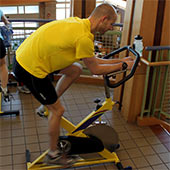 Indoor cycling bikes use a different resistance system altogether. They utilize a heavy flywheel (usually 30 to 40 pounds or more) and a leather or felt brake pad that you adjust with a knob. This resistance system is typically quiet and very durable, while allowing for resistance micro-adjustability so you can set the difficulty to exactly the level that feels right. Generally, a heavier flywheel will result in a smoother pedaling action.
Indoor cycling bikes use a different resistance system altogether. They utilize a heavy flywheel (usually 30 to 40 pounds or more) and a leather or felt brake pad that you adjust with a knob. This resistance system is typically quiet and very durable, while allowing for resistance micro-adjustability so you can set the difficulty to exactly the level that feels right. Generally, a heavier flywheel will result in a smoother pedaling action.
And, a few exercise bikes utilize air resistance that increases as you pedal harder. Unlike the other resistance systems mentioned above, the resistance typically can't be set to a precise level, and these bikes will be louder. Often, the air flywheel on these bikes will provide a cooling effect to the user because it acts as a fan.
Stability, Durability and Frame Construction
An exercise bike must feel strong and stable underneath you during all your workouts. While on most exercise bikes, this consists of seated pedaling, on indoor cycling bikes, this may include standing and riding out of the saddle so be sure to ride any bike you're considering, and in the way you plan to ride it to check how it performs.
And, because a stationary bike won’t help you in the long term if it doesn’t hold up to repetitive use, durability should always be among the key criteria when selecting a new exercise bike. Durable exercise bikes include:
- Smooth, quiet resistance mechanisms with minimal moving parts
- Smooth, quiet, non-slipping belts (usually a Poly-V belt), or strong, long-lasting chains
- A sturdy frame constructed of steel and/or aluminum
- Long-lasting points of contact (pedals and handlebars)
Stable exercise bikes will feel solid underneath you and won’t rock from side to side during easy or vigorous workouts. You should especially focus on attaining the most durability and 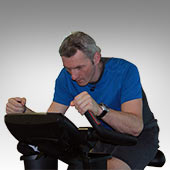 stability your dollar can buy if your stationary bike will be used by:
stability your dollar can buy if your stationary bike will be used by:
- Heavier users
- Multiple users
- Daily or consistent users
- Cyclists, other athletes or anyone performing up-tempo workouts
- Users performing long workouts (one hour or more)
Console Display and Controls
When checking out different exercise bike consoles, your preliminary goal should be finding a user-friendly interface and satisfactory workout feedback. Many stationary bike riders aren’t satisfied without a workout profile, while others prefer a constant readout of calories burned or calories per hour. Most exercisers are driven by a goal of some kind, and if there’s a piece of workout data that helps drive you toward your goal, make sure that crucial feedback is included on your new exercise bike’s console.
The layout and functionality of the bike's controls can affect how much you enjoy your workouts. Make sure that you’re comfortable with the resistance controls because you’ll use these buttons or knobs the most during your workouts. Some upright and recumbents are even equipped with resistance controls mounted on the handlebars.
More and more exercise bikes include additional console and control features designed to enhance the user experience, including:
- Built-in reading racks to allow users to catch up on their reading and pass the time while riding
- Convenient resistance controls mounted on the handlebars
- Integrated fans to keep users cool, make the ride more enjoyable and potentially lengthen workout time
- Varying levels of iPod/MP3 compatibility or connectivity for audio and/or video entertainment to motivate you, help workouts fly by, and maintain training intensity
Heart Rate
Heart-rate monitors are included on many exercise bikes for the purposes of tracking your workout intensity. You can exercise at a heart rate (or heart-rate range) specifically chosen to maximize efficiency for a variety of goal-based workouts, including:
- Burning calories and fat
- Following a personal fitness plan
- Exercising safely per a physician’s prescription or recommendation
- Improving your sport-specific fitness
- Building endurance for cardiovascular health
- Recovering from a previous workout
Exercise bikes monitor your heart rate through contact hand sensors and/or wireless telemetry straps. Here’s a quick breakdown of how and why each system is used:
| Contact Hand Sensors | Wireless Telemetry Straps |
Contact heart-rate monitoring uses hand sensors usually found on the stationary handlebars of the bike. After gripping the hand sensors for several seconds, your heart rate is displayed on the console. If you just want to periodically check your heart rate, or don't prefer to wear a heart-rate strap, an exercise bike that features contact heart rate may be right for you. | A telemetry heart-rate system provides the most accurate monitoring. It uses an adjustable, wireless strap worn around your chest that picks up an electrical impulse from your heart and sends a radio frequency signal to the console. This hands-free system allows a constant heart-rate readout on the console, making it especially useful when performing the built-in, interactive, heart-rate control programs available on many exercise bikes. These programs use automatic resistance adjustments to maintain or vary your heart rate. The most common heart-rate control programs are designed to either maximize fat burning or improve cardiovascular fitness. |
Stand-alone heart-rate monitors are also available, offering the ability to accurately monitor your heart rate on an exercise bike (or any fitness equipment) without built-in heart-rate monitoring, or while exercising outdoors.
Console Programming
Exercise bike programming can take a repetitive aerobic exercise and transform it into a dynamic, challenging hill session, an invigorating interval session or a scientifically based, heart-rate control program. Built-in programs automatically adjust the resistance level to deliver a variety of courses or workouts. Popular program choices include: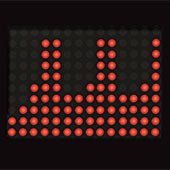
- Random
- Intervals
- Hills
- Heart-rate control
- Preset distance courses
- Goal-based
- Fitness tests
- User-defined (custom) courses
If you’ve had success using a specific exercise bike program at the gym, chances are you’ll be to find a similar program on a bike for your home. Many exercisers will just hop on the bike at the gym and press the quick-start button for a manually controlled workout. But after your stationary bike is assembled, you’ll have time to read the owner’s manual, explore the programming options and learn how a key program can keep you motivated and enhance your fitness regimen. Plus, many exercise bike manufacturers make it easier than ever to use workout programs by incorporating a user ID function. Depending on the bike, a user ID may let you:
- Store personal data (age, weight, etc.) for a quick, user-specific start to workouts programs
- Store workout data, allowing you to track your workout totals, progress, and even personal bests
- Memorize workouts, letting you repeat (or even compete against) previous favorite workouts
The Fun Part: The Test Drive!
Okay. You should now have a better idea of what’s important to you when shopping for an exercise bike. Now it’s time for the test drive! We highly recommend you (and anyone else who will be using the machine) try out any bike in the specific manner you’ll be using it in your home. To do anything less will provide you with limited feedback and potential disappointment. Here are some tips and questions for you:
- Bring whatever shoes you’ll be wearing while exercising at home. Cyclists may also want to bring along their cycling shorts.
- On exercise bikes that allow a pedal change, cyclists may even want to bring along their outdoor pedals and shoes if they’ll be using them at home on their new exercise bike.
- Make sure you’re comfortable getting on and off the stationary bike. More and more recumbent bikes now feature step-through frames for easy access to the seat for example.
- When you’re testing a bike that features electronically adjusted resistance, be sure to turn on the machine and adjust the resistance to a level that you’d use during a workout. How an exercise bike feels while just spinning freely isn’t nearly as important as how it feels while the resistance is activated. Make sure the bike feels smooth and comfortable while pedaling.
- Pay close attention to how the seat feels. And know that a seat that feels soft and cushy at the start may not feel so comfortable late in a workout. The longer you ride, a supportive seat becomes more important than a cushy seat.
- Recumbent bikes are built around seat comfort, so make sure you play with all available seat adjustments to ensure that you’ll be comfortable at all times while pedaling.
- With indoor cycling bikes, test out the bike in all the ways that you’ll be riding it at home. Try riding in and out of the saddle. And, make sure that you’re comfortable with any type of aero bars or multiple-position handlebars. Most indoor cycling bikes allow more seat and handlebar adjustments than a traditional upright bike. Take the time to make these adjustments to determine that you’ll be comfortable on the bike.
- Depending on the type of exercise bike, make sure you’re comfortable adjusting the seat and handlebars, console controls, remote resistance buttons or resistance knob.
- Do the frame, handlebars and seat feel sturdy and stable while you’re riding?
- Is the key workout statistic (if applicable) you’re interested in constantly displayed or only shown periodically as the console display scans?
- Do the pedals, pedal straps or toe cages (if applicable) feel comfortable? Do they fit your feet? Are the pedal straps easy to adjust? Does the pedal spacing feel comfortable for your knees and hips?
- Spend enough time to see how an exercise bike feels and sounds when you exercise at various speeds.
- If reading during your workout is important to you, bring along a few favorite magazines to test out the reading rack. On recumbent bikes, a console reading rack is usually too far away to be useful, but the wide, low-profile seat allows most riders to hold a magazine or book during their workout.
- With a dual-action bike, are you comfortable with the feel and range of motion of the upper-body handles?
- If the exercise bike includes bottle holders and/or accessory trays, are they conveniently positioned and easy to reach?
- Will the bike fit where you want to put it in your home? Bring a tape measure, and be sure to determine your head height at its peak position to make sure you won't bump into your ceiling at home.
- Most exercise bikes include transport wheels, so make sure that you can roll the bike from one place to another if moving the bike is important to you.

